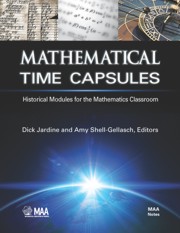Book contents
- Frontmatter
- Preface
- Contents
- 1 The Sources of Algebra
- 2 How to Measure the Earth
- 3 Numerical solution of equations
- 4 Completing the Square through the Millennia
- 5 Adapting the Medieval “Rule of Double False Position” to the Modern Classroom
- 6 Complex Numbers, Cubic Equations, and Sixteenth-Century Italy
- 7 Shearing with Euclid
- 8 The Mathematics of Measuring Time
- 9 Clear Sailing with Trigonometry
- 10 Copernican Trigonometry
- 11 Cusps: Horns and Beaks
- 12 The Latitude of Forms, Area, and Velocity
- 13 Descartes' Approach to Tangents
- 14 Integration à la Fermat
- 15 Sharing the Fun: Student Presentations
- 16 Digging up History on the Internet: Discovery Worksheets
- 17 Newton vs. Leibniz in One Hour!
- 18 Connections between Newton, Leibniz, and Calculus I
- 19 A Different Sort of Calculus Debate
- 20 A ‘Symbolic’ History of the Derivative
- 21 Leibniz's Calculus (Real Retro Calc.)
- 22 An “Impossible” Problem, Courtesy of Leonhard Euler
- 23 Multiple Representations of Functions in the History of Mathematics
- 24 The Unity of all Science: Karl Pearson, the Mean and the Standard Deviation
- 25 Finding the Greatest Common Divisor
- 26 Two-Way Numbers and an Alternate Technique for Multiplying Two Numbers
- 27 The Origins of Integrating Factors
- 28 Euler's Method in Euler's Words
- 29 Newton's Differential Equation ẏ/ẋ = 1 − 3x + y + xx + xy
- 30 Roots, Rocks, and Newton-Raphson Algorithms for Approximating √2 3000 Years Apart
- 31 Plimpton 322: The Pythagorean Theorem, More than a Thousand Years before Pythagoras
- 32 Thomas Harriot's Pythagorean Triples: Could He List Them All?
- 33 Amo, Amas, Amat! What's the sum of that?
- 34 The Harmonic Series: A Primer
- 35 Learning to Move with Dedekind
- About the Editors
23 - Multiple Representations of Functions in the History of Mathematics
- Frontmatter
- Preface
- Contents
- 1 The Sources of Algebra
- 2 How to Measure the Earth
- 3 Numerical solution of equations
- 4 Completing the Square through the Millennia
- 5 Adapting the Medieval “Rule of Double False Position” to the Modern Classroom
- 6 Complex Numbers, Cubic Equations, and Sixteenth-Century Italy
- 7 Shearing with Euclid
- 8 The Mathematics of Measuring Time
- 9 Clear Sailing with Trigonometry
- 10 Copernican Trigonometry
- 11 Cusps: Horns and Beaks
- 12 The Latitude of Forms, Area, and Velocity
- 13 Descartes' Approach to Tangents
- 14 Integration à la Fermat
- 15 Sharing the Fun: Student Presentations
- 16 Digging up History on the Internet: Discovery Worksheets
- 17 Newton vs. Leibniz in One Hour!
- 18 Connections between Newton, Leibniz, and Calculus I
- 19 A Different Sort of Calculus Debate
- 20 A ‘Symbolic’ History of the Derivative
- 21 Leibniz's Calculus (Real Retro Calc.)
- 22 An “Impossible” Problem, Courtesy of Leonhard Euler
- 23 Multiple Representations of Functions in the History of Mathematics
- 24 The Unity of all Science: Karl Pearson, the Mean and the Standard Deviation
- 25 Finding the Greatest Common Divisor
- 26 Two-Way Numbers and an Alternate Technique for Multiplying Two Numbers
- 27 The Origins of Integrating Factors
- 28 Euler's Method in Euler's Words
- 29 Newton's Differential Equation ẏ/ẋ = 1 − 3x + y + xx + xy
- 30 Roots, Rocks, and Newton-Raphson Algorithms for Approximating √2 3000 Years Apart
- 31 Plimpton 322: The Pythagorean Theorem, More than a Thousand Years before Pythagoras
- 32 Thomas Harriot's Pythagorean Triples: Could He List Them All?
- 33 Amo, Amas, Amat! What's the sum of that?
- 34 The Harmonic Series: A Primer
- 35 Learning to Move with Dedekind
- About the Editors
Summary
Introduction (A Funny Thing Happened on the Way to Calculus)
During the fall semester of 2005, I was slated to teach University Calculus I to a class of mostly incoming freshmen. It had been a while since I taught both the class and freshmen, so on the first day I decided to do some review and pick my students' brains. I wrote y = f(x2) on the board and asked if that was a function. The unanimous answer was yes. Without exploring that too much, I drew Figure 23.1 on the board and asked if that was a function.
The response was overwhelmingly yes and when I asked why, the response was that it passed the vertical line test. I then wrote the following on the board.
c(x) = the cost (in cents) to send a first class letter
weighing x ounces through the US Postal service.
When asked if that was a function, about half of the class said it was and about half said it wasn't. From the looks on people's faces, the majority of students in the class were not sure of their answers either. After having students discuss their thoughts with their neighbors, we had a class discussion about whether it was, in fact, a function or not. The gist of people who said no was that it wasn't a function because there was no formula or graph with which to determine specific values. The people who said yes said that it was still a rule that assigned a unique value to each x.
There was still no definite consensus when I drew Figure 23.2 on the board.
Information
- Type
- Chapter
- Information
- Mathematical Time CapsulesHistorical Modules for the Mathematics Classroom, pp. 179 - 188Publisher: Mathematical Association of AmericaPrint publication year: 2011
